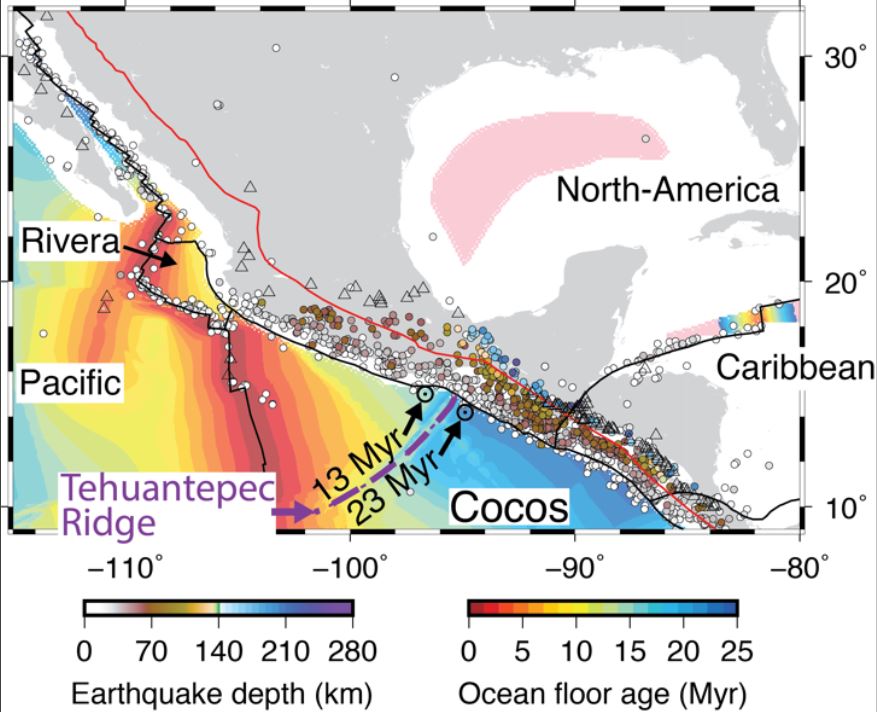6 September 2019
New research provides better look at ocean plate under Central America
Posted by larryohanlon
By Anselme F.E. Borgeaud, Kenji Kawai and Robert J. Geller
Convection in Earth’s mantle is the “engine” driving plate tectonics. Hot material rises to the Earth’s surface from the boundary between the planet’s core and mantle, at a depth of about 3000 kilometers. Cold material then flows downward due to oceanic tectonic plates sinking into the mantle at subduction zones on the Earth’s surface.
Seismologists have long sought to understand this convection cycle by imaging subducting slabs as they descend into Earth’s depths at oceanic trenches. To do this they have used a technique called seismic tomography, which is similar to a medical ultrasound scan.
A new study in AGU’s Journal of Geophysical Research: Solid Earth, used a new, higher resolution, tomographic technique called waveform inversion to image the oceanic plate subducting beneath Central America, the Cocos plate. This allowed resolution of finer details than previous work.
The new findings contribute to improving our understanding of the dynamics of slabs as they reach the bottom of the upper mantle at a depth of about 670 kilometers below the Earth’s surface and help scientists better understand the convection cycle driving plate tectonics.
The new study used records of S-wave (seismic shear wave) triplications from earthquakes in Central America recorded at the USArray, a large array of seismic receivers deployed from 2004 to 2015 in the contiguous US. Waveform triplications occur when several S-waves that travel along slightly different paths arrive at an observatory at almost the same time. The complex waveforms are difficult to interpret using traditional travel-time tomography, but can be readily analyzed by waveform inversion to extract all available information on the structure around depths of 670 kilometers.
Central America is a geologically interesting region because of the large variations in the age of the Cocos plate at the trench, from about 2 million years old to the north, at about the latitude of Mexico City, to about 30 million years old to the south, at about the latitude of Costa Rica, with an age jump of about 10 million years across a past fracture zone called the Tehuantepec Ridge beneath southern Mexico.

Ocean floor ages for the Cocos plate (and other plates in the Pacific) subducting beneath the North-America and Caribbean plates. Location of the Tehuantepec Ridge is shown by the purple dashed curve.
Oceanic plates at the Earth’s surface cool with increasing age, which means that older plates are both denser and have higher viscosity when they enter the oceanic trench; they thus can sink more easily into the mantle than younger plates. The 3-D S-velocity model obtained by this study shows that variations in the age of the plate along the trench correlate well with variations in the shape of the slab at depth, suggesting that there are local variations in density and viscosity of the Cocos slab at depth due to variations in age.
The study also identified the presence of a possible upwelling of warm material, called a “plume,” rising from the lower mantle beneath the northern part of the Cocos slab, which could also affect how the Cocos slab sinks into the upper mantle.

Left: Vertical sections through the inferred tomographic images showing significant deformation of the Cocos slab to the north (blue region in top panel), but not to the south (bottom panel). Right: Map view of structure from 370-410 km depth, showing a possible tear in the Cocos slab. (Note: Velocities are relative to the average global velocity at each depth.)
Furthermore, the inferred images reveal that the Cocos slab possibly tears at a depth of about 400 kilometers along the Tehuantepec Ridge. This might be explained by the difference in density of the Cocos slab north and south of the Tehuantepec Ridge, and by the fact that the Tehuantepec Ridge is probably a weak zone in the slab, which should facilitate tearing. Comparison with surface geological evidence also indicates that this tear occurred about 10 million years ago, which implies an average sinking rate of slabs in the upper mantle of about 4 centimeters per year. This can be used to place constraints on the viscosity of the upper mantle in this region.
Previous studies have shown large regional variability in the dynamics of slabs as they reach the bottom of the upper mantle. In the near future, it should be possible to apply the methods of this study to other subduction zones in order to better understand the physical causes behind the variability of subduction.
Anselme F.E. Borgeaud, Kenji Kawai and Robert J. Geller are associated with the Department of Earth and Planetary Science, School of Science, University of Tokyo, Tokyo, Japan. Borgeaud is currently at the Institute of Earth Sciences, Academia Sinica, Taipei, Taiwan. They are the authors of the research being reported.


 GeoSpace is a blog on Earth and space science, managed by AGU’s Public Information staff. The blog features posts by AGU writers and guest contributors on all sorts of relevant science topics, but with a focus on new research and geo and space sciences-related stories that are currently in the news.
GeoSpace is a blog on Earth and space science, managed by AGU’s Public Information staff. The blog features posts by AGU writers and guest contributors on all sorts of relevant science topics, but with a focus on new research and geo and space sciences-related stories that are currently in the news.